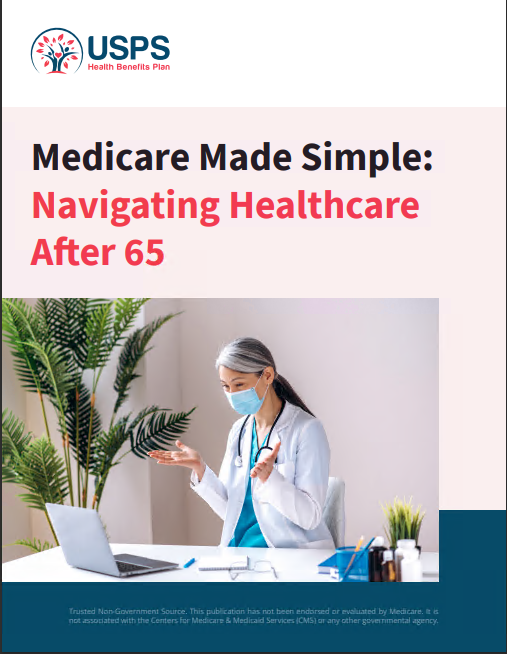Key Takeaways
-
Understanding how Medicare works with PSHB can help you avoid unexpected costs and coverage gaps.
-
Reviewing your options annually ensures you’re making the best choice for your healthcare needs.
Navigating Medicare Enrollment as a PSHB Member
Enrolling in Medicare as a member of the Postal Service Health Benefits (PSHB) program requires careful planning. With different coverage options, cost considerations, and integration rules, making the right choice can be overwhelming. Here are four key factors to consider before enrolling in Medicare under PSHB.
1. Understanding Medicare Part A and Part B Enrollment Rules
Medicare Part A: Hospital Coverage
Medicare Part A covers hospital stays, skilled nursing facility care, hospice, and some home healthcare services. Most people qualify for premium-free Part A if they have worked and paid Medicare taxes for at least 10 years (40 quarters). If you don’t qualify, you may have to pay a monthly premium.
Since PSHB provides hospital coverage, you might wonder if enrolling in Part A is necessary. While you can technically delay it, signing up for Part A is generally beneficial because it can lower your out-of-pocket costs when used alongside PSHB benefits.
Additionally, Part A covers services that PSHB might not, such as hospice care and certain home healthcare services, making it a valuable addition to your overall coverage. Even if you are still working, considering early enrollment can prevent gaps in coverage once you retire.
Medicare Part B: Medical Coverage
Medicare Part B covers doctor visits, outpatient care, preventive services, and durable medical equipment. Unlike Part A, everyone must pay a monthly premium for Part B. If you’re a Medicare-eligible annuitant under PSHB, enrolling in Part B is required to maintain PSHB coverage.
By having both PSHB and Part B, you can minimize your out-of-pocket costs. PSHB plans typically reduce their deductibles and copays when you have Part B, ensuring that medical expenses remain manageable. This combination also helps in cases of high medical costs, as Medicare becomes the primary payer, reducing your burden significantly.
Enrollment Timing
-
Initial Enrollment Period (IEP): Starts three months before you turn 65, includes your birth month, and extends three months after.
-
Special Enrollment Period (SEP): If you’re still working and covered under PSHB as an employee, you can delay Part B enrollment without penalties and sign up later through SEP.
-
General Enrollment Period (GEP): Runs from January 1 to March 31 each year, with coverage starting in July. Late enrollment penalties may apply.
Understanding these enrollment periods ensures that you avoid penalties and don’t experience a lapse in coverage. Missing your IEP can result in costly late fees, so it’s best to plan ahead and enroll on time.
2. How PSHB Integrates with Medicare
Coordinating Benefits
If you’re enrolled in both PSHB and Medicare, Medicare typically pays first (primary payer), and PSHB serves as the secondary payer. This coordination can lower your out-of-pocket costs for medical services.
Having both plans can be particularly beneficial for specialist visits, lab tests, and medical procedures, as the combined coverage reduces your financial responsibility. However, understanding which services are covered by each program can prevent unexpected bills.
Cost Savings with Medicare
Many PSHB plans reduce deductibles, copays, and coinsurance when you have Medicare. This can help manage expenses for hospital visits, doctor appointments, and prescriptions. Some PSHB plans also offer Medicare Part B premium reimbursements, but this varies by plan.
Additionally, Medicare Part B covers a variety of preventive services, including screenings, vaccines, and wellness visits, often at no additional cost. Using these benefits effectively can help you maintain better long-term health and catch potential issues early.
Prescription Drug Coverage
If you’re enrolled in Medicare, PSHB plans automatically provide a Medicare Part D Employer Group Waiver Plan (EGWP). This coverage helps reduce prescription drug costs and ensures comprehensive medication access.
One advantage of this integration is the potential for lower prescription drug costs. Since Part D includes a $2,000 annual out-of-pocket cap in 2025, it provides financial protection against high medication expenses. Be sure to review your PSHB plan’s prescription coverage to ensure it aligns with your medication needs.
3. Cost Considerations When Choosing Medicare with PSHB
Premiums, Deductibles, and Out-of-Pocket Costs
-
Medicare Part A: Free for most enrollees, but those who pay premiums should compare costs with their PSHB plan.
-
Medicare Part B: The standard monthly premium is $185 in 2025. High-income earners pay more due to the Income-Related Monthly Adjustment Amount (IRMAA).
-
Deductibles and Copays: Medicare and PSHB each have their own cost-sharing rules. Check your plan’s out-of-pocket maximums to estimate potential expenses.
By analyzing these costs, you can determine whether enrolling in Medicare alongside PSHB will save you money. Many retirees find that their total out-of-pocket spending decreases with this combination, but it depends on your healthcare usage.
What Happens If You Delay Medicare?
If you delay Part B when required, you’ll face late enrollment penalties, which permanently increase your premiums. For PSHB retirees, delaying Part B could result in losing PSHB coverage altogether.
Additionally, delaying Part B means that PSHB won’t coordinate benefits with Medicare, potentially leading to higher out-of-pocket costs. Ensuring timely enrollment prevents these complications and allows for better financial planning.
4. Reviewing and Updating Your Coverage Annually
Why You Should Reevaluate Your Plan Each Year
Medicare and PSHB plans change annually. Costs, covered services, and benefits can shift, so reviewing your coverage during Medicare Open Enrollment (October 15 – December 7) and PSHB Open Season (November 11 – December 13, 2025) is crucial.
Reviewing your coverage helps you stay informed about policy changes and cost adjustments. Even small modifications in premiums or deductibles can impact your budget, so it’s essential to compare options yearly.
Checking Plan Changes
Review your plan’s Annual Notice of Change (ANOC) to see updates in premiums, cost-sharing, and benefits. If your healthcare needs change, switching plans during Open Season ensures you have the best coverage.
Seeking Assistance
Choosing the right combination of Medicare and PSHB coverage can be complex. Speaking with a licensed agent listed on this website can help you understand your options and make an informed decision.
An agent can clarify how different plans interact and ensure that you maximize available benefits. Getting expert advice can save time and prevent costly mistakes.
Making the Right Choice for Your Healthcare Needs
Navigating Medicare enrollment as a PSHB member requires a solid understanding of how the two programs work together. By evaluating your Medicare eligibility, coordinating PSHB benefits, assessing costs, and reviewing your plan annually, you can make confident decisions that align with your healthcare needs.










